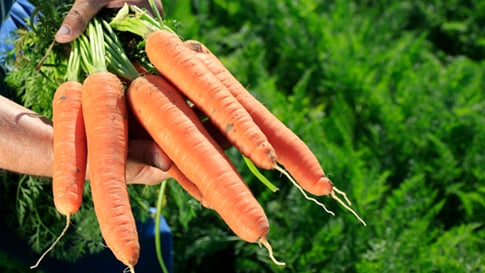Growing Carrots
Crop Nutrition Advice
Everything you need to know about carrot fertilization, best practice, suitable products, field trials and more.
Advice for growing Carrots (Daucus carota)
-
Optimum pH range lies between 5.5 – 7.0.
-
At soil pH <5.5, carrot is susceptible to phosphate, molybdenum and calcium deficiencies.
-
At soil pH > 7,5, deficiencies of boron, copper, iron, manganese, phosphate and zinc are likely to appear.

Carrots harvested in optimum condition

Growing carrots
Nutrient requirements
Estimated nutrient uptake (kg/t):
| Early-medium-late varieties (60 ton/ha) | N kg/t | P2O5 kg/t | K2O kg/t | MgO kg/t | CaO kg/t |
|---|---|---|---|---|---|
| Leaves | 60 | 21 | 170 | 13 | 70 |
| Root | 80 | 12 | 151 | 8 | 18 |
| Total | 140 | 33 | 321 | 21 | 88 |
| Late and very late varieties (140 ton/ha) | N kg/t | P2O5 kg/t | K2O kg/t | MgO kg/t | CaO kg/t |
|---|---|---|---|---|---|
| Leaves | 40 | 9 | 97 | 17 | 126 |
| Root | 110 | 69 | 303 | 17 | 56 |
| Total | 150 | 78 | 400 | 34 | 182 |
Recommendations for the different nutrients depends on soil fertility.
Carrot is susceptible for high salt concentrations, especially at seedling stage.
Fertilization methods
Nitrogen
Using a granular fertilizer, apply before seeding approx. 80 kg/ha of N minus N- mineral in the soil (0-60 cm). The rest could be split over the crop cycle either on weekly basis, via fertigation, or 2-3 applications of conventional granular N based products.
However, in non-fertigated crops, using Controlled Release Fertilizers allows application of the entire amount of N, before seeding, thus avoiding multiple top-dressings.
Phosphate
Could be applied entirely at the beginning of crop cycle, before seeding.
Potassium
Knowing that potassium leaches as easily as nitrate, the entire amount that crop needs should be split in 2-3 applications in non-fertigated crop systems or using only once, before seeding, a coated K based product.
In fertigated crops, supplying potassium on weekly basis is strongly recommended.
Magnesium
Could be applied entirely at the beginning of the crop cycle, before seeding. Nevertheless foliar applications will further improve crop performance.
Calcium
Could be applied entirely at the beginning of the crop cycle, before seeding.



